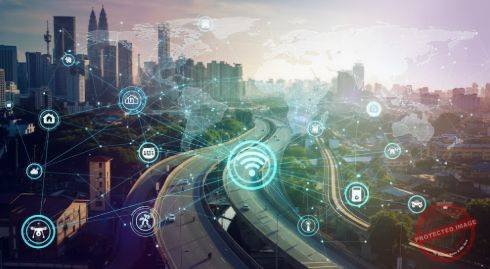Where Artificial Intelligence Meets the Internet of Things—Driving Real-Time Decisions, Smarter Devices, and Connected Autonomy.
The Rise of Edge Intelligence
The Internet of Things (IoT) has grown exponentially, connecting billions of devices across industries—from autonomous vehicles and industrial robots to smart sensors and wearable health monitors. But as data volumes surge, sending every byte to centralized cloud servers for processing has become inefficient and unsustainable.
Enter Edge Intelligence—the fusion of Artificial Intelligence (AI) with edge computing. This paradigm shift moves computation closer to where data is generated, enabling real-time analysis, faster response times, and reduced bandwidth consumption.
In 2025, Edge AI is no longer an emerging trend—it’s becoming the architectural cornerstone of next-generation IoT systems.
From Cloud Dependency to Distributed Intelligence
For years, IoT devices relied heavily on cloud processing. Sensors collected data and transmitted it upstream to centralized servers for interpretation. This model, while powerful, introduced latency, increased operational costs, and posed privacy risks.
Edge Intelligence flips that model. Instead of routing raw data to the cloud, AI models now run locally on gateways, embedded processors, or even the devices themselves.
The result is a distributed ecosystem where decisions happen in milliseconds—crucial for applications like self-driving vehicles, factory robotics, and real-time patient monitoring.
AI Models Shrinking for the Edge
One of the most significant enablers of Edge Intelligence is the evolution of lightweight AI models optimized for resource-constrained environments.
Frameworks such as TensorFlow Lite, PyTorch Mobile, and OpenVINO have made it possible to deploy neural networks directly onto IoT devices. Coupled with specialized hardware—like NVIDIA Jetson, Google Coral, and Intel Movidius chips—AI inference can now happen on the edge without sacrificing accuracy.
This shift allows IoT systems to operate independently, intelligently, and efficiently, even in environments with limited or intermittent connectivity.
The Benefits of Thinking Locally
Edge AI brings tangible advantages across key performance metrics:
-
Ultra-Low Latency: Critical decisions, such as obstacle detection or machine fault alerts, are made instantly.
-
Enhanced Privacy: Sensitive data is processed locally, reducing exposure during transmission.
-
Lower Bandwidth Usage: Only relevant insights or anomalies are sent to the cloud, minimizing network strain.
-
Greater Reliability: Edge nodes continue to function even if cloud connectivity is lost.
These benefits are transforming how industries approach automation, security, and scalability in connected systems.
Edge Intelligence Across Industries
Edge Intelligence is creating seismic shifts across multiple sectors:
-
Manufacturing: Predictive maintenance algorithms detect equipment anomalies in real time, reducing downtime.
-
Healthcare: Edge-enabled wearables analyze biometric data instantly, alerting medical teams to early warning signs.
-
Retail: Smart cameras and sensors optimize inventory, monitor shopper behavior, and personalize experiences.
-
Transportation: Connected vehicles process sensor data locally for collision avoidance and route optimization.
-
Energy: Smart grids use AI at substations to balance loads dynamically, improving energy efficiency.
Each deployment underscores the transformative potential of decentralizing intelligence across the IoT ecosystem.
Security and Data Sovereignty at the Edge
While edge computing improves privacy by keeping data local, it also introduces new security challenges. Each edge node becomes a potential attack surface that must be secured.
To counter this, organizations are implementing Zero Trust architectures at the edge—verifying every transaction and enforcing strong identity management for devices. AI also plays a defensive role, using anomaly detection models to identify threats autonomously at the edge before they propagate through the network.
Furthermore, data sovereignty regulations such as GDPR and CCPA are accelerating the adoption of localized data processing models that align with regional compliance laws.
The Convergence of Edge, Cloud, and 5G
The future of IoT lies not in choosing between the cloud and the edge—but in orchestrating both through intelligent coordination.
Edge computing handles immediate decision-making, while cloud systems manage training, large-scale analytics, and long-term optimization. The rollout of 5G networks enhances this balance by providing ultra-fast, low-latency connectivity between edge devices and the cloud, creating a seamless continuum of intelligence.
This multi-tiered architecture—edge, fog, and cloud—forms the digital backbone of tomorrow’s connected world.
Closing Thoughts and Looking Forward
Edge Intelligence marks a defining moment in the evolution of the Internet of Things. By moving AI closer to the source of data, organizations are unlocking faster, safer, and more autonomous operations across every industry.
As AI models become more efficient and hardware more powerful, the line between “device” and “data center” will continue to blur. In this new era, intelligence won’t just live in the cloud—it will live everywhere.
The fusion of AI and IoT at the edge isn’t just a technological upgrade—it’s the foundation of the next industrial and digital revolution.
References
-
“The Future of Edge AI and IoT” – Forbes Tech Council
https://www.forbes.com/sites/forbestechcouncil/2024/04/17/the-future-of-edge-ai-and-iot -
“How Edge Computing Is Transforming the Internet of Things” – Gartner Insights
https://www.gartner.com/en/articles/how-edge-computing-is-transforming-the-internet-of-things -
“AI at the Edge: Accelerating Intelligence Everywhere” – NVIDIA Developer Blog
https://developer.nvidia.com/blog/ai-at-the-edge-accelerating-intelligence-everywhere -
“5G and Edge: The Dynamic Duo Driving IoT Innovation” – TechRepublic
https://www.techrepublic.com/article/5g-and-edge-the-dynamic-duo-driving-iot-innovation/ -
“Securing AI at the Edge” – Dark Reading
https://www.darkreading.com/edge/securing-ai-at-the-edge
Author: Serge Boudreaux – AI Hardware Technologies, Montreal, Quebec
Co-Editor: Peter Jonathan Wilcheck – Miami, Florida
Post Disclaimer
The information provided in our posts or blogs are for educational and informative purposes only. We do not guarantee the accuracy, completeness or suitability of the information. We do not provide financial or investment advice. Readers should always seek professional advice before making any financial or investment decisions based on the information provided in our content. We will not be held responsible for any losses, damages or consequences that may arise from relying on the information provided in our content.



